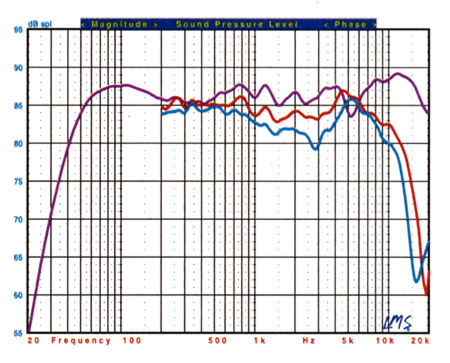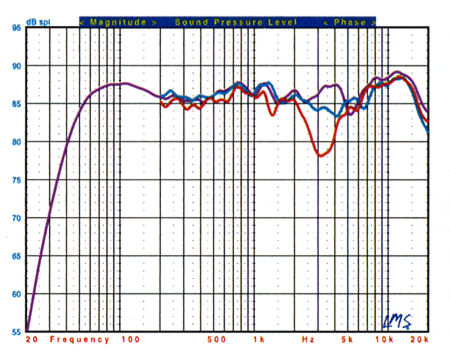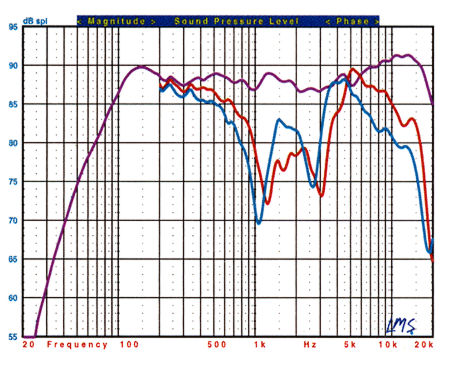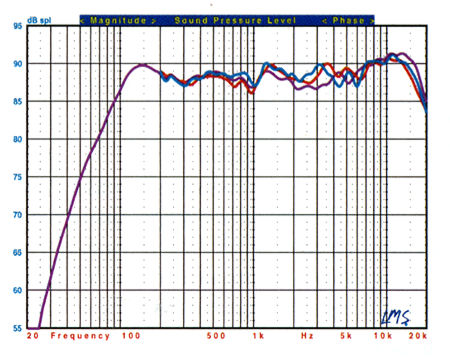Tannoy Fusion surround speaker system Calibration
All measurements were made with the grilles removed. The Fusion 3's sensitivity measured approximately 86dB/W/m. Its ported cabinet is tuned to about 45Hz. Its minimum impedance is 5ohms at 6kHz, and I would rate its nominal impedance at 7ohms. While its impedance is quite capacitive at both 90Hz and 1.8kHz, its relatively high magnitude at those frequencies results in a load that should be of average difficulty to drive.

Fig.1: Tannoy Fusion 3, pseudo-anechoic horizontal response at 45° (red) and 60° (blue) relative to tweeter axis.
The pseudo-anechoic response of the Fusion 3 at tweeter height, averaged over a 30° forward horizontal angle and combined with the nearfield responses of the woofer and port, is shown in Fig.1 (violet). The useful bass extends down to about 37Hz with the port open, and to 46Hz with the plug in place (both –10dB relative to the output at 80Hz). The on-axis average is a little bumpy but relatively free of aberrations, apart from a little forwardness through the midrange and a more significant elevation in the treble that extends from 6kHz to 16kHz and reaches a maximum of about +4dB at 10kHz.

Fig.2: Tannoy Fusion 3, pseudo-anechoic vertical response at +15° (red) and –15° (blue) relative to tweeter axis.
The off-axis response is actually a little flatter up to 45°, though at wider angles a significant suckout appears at about 3kHz. This is likely due to the limited off-axis dispersion of the woofer at the top of its range.
Fig.2 again shows the Fusion 3's averaged horizontal front response (violet), plus the vertical responses taken at +15° (red) and –15° (blue) relative to the tweeter. The responses are well matched at and below the tweeter, but the dip at about 3kHz at the +15° angle suggests that if you can see the top of the cabinet from your listening chair, your ears may be too high to hear the best performance from the speaker.
The Fusion C center-channel's cabinet is tuned to about 75Hz. I would rate its nominal impedance at 6ohms; the minimum impedance was 4.25ohms at 5kHz. It also dips to 4.4ohms at 270Hz. The speaker's sensitivity measured approximately 88dB/W/m. Its impedance characteristics should make it of average difficulty to drive.

Fig.3: Tannoy Fusion C, pseudo-anechoic horizontal response at 45° (red) and 60° (blue) to left of tweeter axis.
The measured front horizontal response of the Fusion C, taken on the tweeter axis and averaged in the same manner as described above for the Fusion 3, is shown in Fig.3 (violet). The useful bass extension is approximately 69Hz with the port open, 87Hz with it closed (both points –10dB relative to the output at 80Hz). The on-axis response is well matched to that of the Fusion 3, including a similar bump at the top end (not surprising; it uses the same tweeter).
Off-axis, however, the Fusion C develops the type of suckout we've seen in every center-channel speaker we've tested that has horizontally arrayed drivers. In the Tannoy, it's particularly bad. You can clearly hear the loss of presence in the sound as you move beyond 30° off-axis, though surprisingly, it's not as severe, audibly, as the curve might lead you to believe.

Fig.4: Tannoy Fusion C, pseudo-anechoic vertical response at +15° (red) and –15° (blue) relative to tweeter axis.
The Fusion C's vertical off-axis response (Fig.4) shows a very tight cluster. While you can tilt the speaker down if you mount it above a rear-projection set (as I did for my listening), it's not really necessary.
Apart from the Fusion C's off-axis suckout (very common in such designs), this is a respectable set of measurements for a relatively low-priced system.—TJN





























































